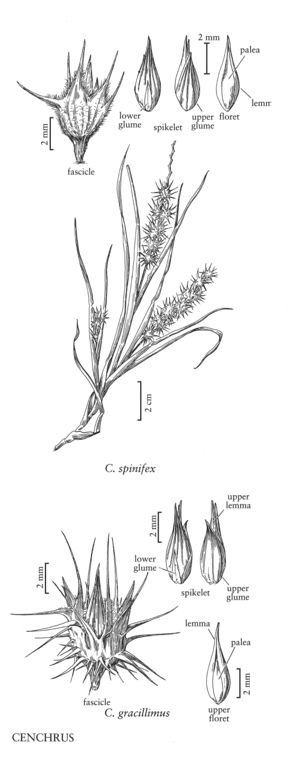Cenchrus gracillimus
Plants perennial; sometimes forming dense clumps. Culms 20-80 cm, wiry. Sheaths shorter than the internodes, keeled, usually glabrous, rarely sparsely pilose; ligules 0.2-0.6 mm; blades 5-25 cm long, 1-3.5 mm wide, stiff, adaxial surfaces usually glabrous, smooth or scabrous. Panicles 2-6(6.8) cm; rachis internodes 2-4 mm; fascicles 5-13 mm long, 2-4 mm wide, not imbricate, ovoid, glabrous; outer bristles sometimes present, flattened; inner bristles less than 30, 3.2-6 mm long, 0.2-1 mm wide at the base, in more than 1 whorl, fused for at least 1/2 their length into a distinct cupule, diverging at irregular intervals from the cupule, somewhat flattened, spreading, purple-tipped at maturity. Spikelets 1-3 per fascicle, 4-7 mm. Lower glumes 1.4-3.1 mm; upper glumes 3.2-5.4 mm, 3-5-veined; upper lemmas 4-6 mm, 3-5-veined; upper florets 3.9-6.5 mm; anthers 0.9-1.9 mm. Caryopses 1.8-3 mm long, 1-1.5 mm wide, ovoid-elliptic. 2n = 34.
Distribution
Puerto Rico, Miss., Fla., Ala., Ga.
Discussion
Cenchrus gracillimus grows in sandy soils of open pinelands, wet prairies, and river flats of the southeastern United States and the West Indies.
Selected References
None.
